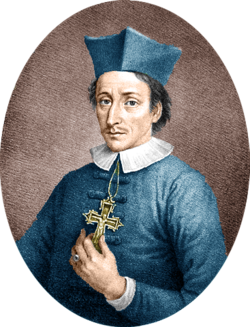Niels Steensen | |
|---|---|
| Vicar Apostolic of Nordic Missions | |
 Portrait of Steno as bishop (1868) | |
| See | Titiopolis |
| Appointed | 21 August 1677 by Pope Innocent XI |
| Term ended | 5 December 1686 |
| Predecessor | Valerio Maccioni |
| Successor | Friedrich von Tietzen[a] |
| Other post(s) | Titular Bishop of Titiopolis |
| Previous post(s) |
|
| Orders | |
| Ordination | 13 April 1675[2] |
| Consecration | 19 September 1677 by Saint Gregorio Barbarigo[3][4] |
| Personal details | |
| Born | Niels Steensen 1 January 1638 [NS: 11 January 1638] |
| Died | 25 November 1686 (aged 48) [NS: 5 December 1686] Schwerin, Duchy of Mecklenburg-Schwerin |
| Buried | Basilica of San Lorenzo, Italy |
| Nationality | Danish |
| Denomination | Roman Catholic |
| Parents | |
| Occupation |
|
| Coat of arms |  |
| Sainthood | |
| Feast day | 5 December |
| Venerated in | Roman Catholic Church |
| Beatified | 23 October 1988 Rome, Vatican City by Pope John Paul II |
Niels Steensen (Danish: Niels Steensen; Latinized to Nicolas Steno[b] or Nicolaus Stenonius;[c][8] 1 January 1638 – 25 November 1686[9][10] [NS: 11 January 1638 – 5 December 1686][9]) was a Danish scientist, a pioneer in both anatomy and geology who became a Catholic bishop in his later years.
Steensen was trained in the classical texts on science; however, by 1659 he seriously questioned accepted knowledge of the natural world.[11] Importantly he questioned explanations for tear production, the idea that fossils grew in the ground and explanations of rock formation. His investigations and his subsequent conclusions on fossils and rock formation have led scholars to consider him one of the founders of modern stratigraphy and modern geology.[12][13] The importance of Steensen's foundational contributions to geology may be gauged from the fact that half of the twenty papers in a recent miscellany volume on The Revolution in Geology from the Renaissance to the Enlightenment focus on Steensen, the "preeminent Baroque polymath and founder of modern geologic thought".[14]
Born to a Lutheran family, Steensen converted to Catholicism in 1667. After his conversion, his interest in the natural sciences rapidly waned giving way to his interest in theology.[15] At the beginning of 1675, he decided to become a priest. Four months later, he was ordained in the Catholic clergy on Easter Sunday in 1675. As a clergyman, he was later appointed Vicar Apostolic of Nordic Missions and Titular Bishop of Titopolis by Pope Innocent XI. Steensen played an active role in the Counter-Reformation in Northern Germany.
His canonization process began in 1938 and Pope John Paul II beatified Steensen in 1988.[16]
- ^ Janker, Stephan M. (1990). Die Bischöfe des Heiligen Römischen Reiches : ein biographisches Lexikon (in German). Berlin: Duncker und Humblot. p. 516. ISBN 978-3-428-06763-3.
- ^ Kermit (2002), p. 19.
- ^ Miniati (2009), Note 26, page 77..
- ^ Pope John XXIII (26 May 1960). "Canonizzazione di S. Gregorio Barbarigo". Homily of His Holiness Pope John XXIII (in Italian). Holy See. Retrieved 14 January 2012.
- ^ Garrett Winter (1916), p. 184..
- ^ Cutler (2003).
- ^ Scherz (2002).
- ^ Garrett Winter (1916), p. 175.
- ^ a b Hansen (1912).
- ^ Aber, James S. (2007). "History of Geology – Steno". Archived from the original on 28 January 2017. Retrieved 11 January 2012.
- ^ Kooijmans (2007).
- ^ Wyse Jackson (2007).
- ^ Woods (2005), pp. 4, 96.
- ^ Gary D. Rosenberg (ed.), The Revolution in Geology from the Renaissance to the Enlightenment (Geological Society of America Memoir 203) (Boulder, Colorado, 2009), p. vii.
- ^ Garrett Winter (1916), pp. 180, 182.
- ^ Office Of Papal Liturgical Celebrations. "Beatifications By Pope John Paul II, 1979–2000". Holy See. Retrieved 11 January 2012.
Cite error: There are <ref group=lower-alpha> tags or {{efn}} templates on this page, but the references will not show without a {{reflist|group=lower-alpha}} template or {{notelist}} template (see the help page).